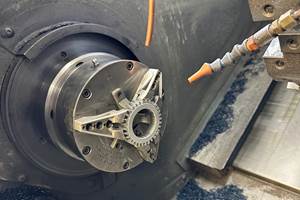Drill Deletes Delamination In CFRP
Composites are becoming increasingly common in aerospace applications, and machining new materials can be a challenge for shops used to cutting metal. One such substance, carbon fiber-reinforced plastic (CFRP), can be difficult to drill because tools often “push” through the material rather than executing a cle
Share


Composites are becoming increasingly common in aerospace applications, and machining new materials can be a challenge for shops used to cutting metal. One such substance, carbon fiber-reinforced plastic (CFRP), can be difficult to drill because tools often “push” through the material rather than executing a clean cut. To address this issue, cutting tool manufacturer OSG Tap and Die has developed a carbide drill featuring specially engineered geometry and a custom diamond coating method that keeps the tool sharp.
Similar to Fiberglass, CFRP is a tough, abrasive material that can quickly wear cutting tools. The material—which, incidentally, makes up much of the fuselage of Boeing’s 787 Dreamliner—is stronger yet lighter than aluminum. To machine CFRP, shops commonly use long-lasting diamond tooling such as PCD insert drills, vein PCD drills or brazed mandrel tools. According to OSG, however, many such cutters can still have a tendency to rip apart the composite layers rather than shearing cleanly through. This can leave unsightly tear marks and compromise the material. The company says such tools may not incorporate the proper relief geometry and edge design to prevent this phenomenon, which is known as “delamination.”
Designed specifically for CFRP applications, OSG’s new drill features larger relief angles for sharpness and chamfers and/or radii on the corners to avoid wear. Beyond these common features, the drills are specially designed for each customer because different geometries are more or less useful depending on the type of CFRP, which is commonly layered with other materials. For example, the company might recommend a variation on a double-angled drill design for a shop machining CFRP embedded with titanium.
Like other cutters commonly used in composite applications, the drill incorporates diamond to extend tool life—a particularly important consideration when machining a tough material like CFRP. In this case, the diamond is a coating applied via chemical vapor deposition (CVD). However, coating applied to a tool or insert often rounds the cutting edge and offsets any tool-life gains by reducing sharpness. The duller the tool, the less likely it is to make a clean cut and avoid delaminating the material.
With this in mind, OSG has developed a custom coating application methodology that keeps the micro-grain structure of the diamond crystals to less than 1 micron. This allows the coating to conform more closely to the contours of the cutting edge, providing the necessary tool life improvements while maintaining sharpness. The custom process involves intensive cleaning and preparation of the carbide tool before applying the diamond coating. The company chemically etches each tool for coating adhesion, while a series of chemical baths control the quantity of cobalt, a material inherent to the carbide substrate. This is important because too much cobalt can cause graphite contamination of the coating, which can result in chipping or flaking issues.
While PCD tools last longer than the CFRP diamond coated drill, OSG says they are more expensive because of the costs involved in their production. Additionally, the small micro-grain structure of the drill’s CVD coating is said to keep the tool sharp, enabling a single tool to cut a hole in CFRP. According to Drew Strauchen, engineering and marketing manager at OSG, this can be advantageous for shops used to employing multiple tools to remove as much material as possible before breakthrough to the other side of the hole, when most delamination occurs.
“When drilling composites, our customers are generally used to drilling the hole in several steps, sometimes using three or four drills to produce one hole,” Mr. Strauchen says. “With ours, they can use one or possibly two drills, saving money and reducing the number of tools in the process.”
Related Content
The Future of High Feed Milling in Modern Manufacturing
Achieve higher metal removal rates and enhanced predictability with ISCAR’s advanced high-feed milling tools — optimized for today’s competitive global market.
Read MoreWorkholding Fixtures Save Over 4,500 Hours of Labor Annually
All World Machinery Supply designs each fixture to minimize the number of operations, resulting in reduced handling and idle spindle time.
Read MoreChuck Jaws Achieve 77% Weight Reduction Through 3D Printing
Alpha Precision Group (APG) has developed an innovative workholding design for faster spindle speeds through sinter-based additive manufacturing.
Read MoreShoulder Milling Cuts Racing Part's Cycle Time By Over 50%
Pairing a shoulder mill with a five-axis machine has cut costs and cycle times for one of TTI Machine’s parts, enabling it to support a niche racing community.
Read MoreRead Next
Exit-Side Drill Penetration Without Delamination
Slow-motion video shows the effect of a micograin tool coating in drilling CFRP.
Read MoreOEM Tour Video: Lean Manufacturing for Measurement and Metrology
How can a facility that requires manual work for some long-standing parts be made more efficient? Join us as we look inside The L. S. Starrett Company’s headquarters in Athol, Massachusetts, and see how this long-established OEM is updating its processes.
Read More




























